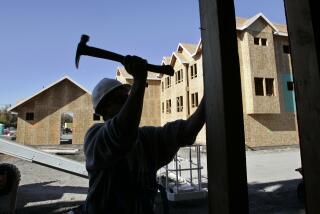Column: Millions of Californians are poor, and they don’t always live where you’d expect

California’s greatest contradiction is almost Dickensian: In a state often cited as home to scores of billionaires, almost 4 in every 10 residents are living at or near the poverty line.
Some live in rural regions removed from the state’s economic recovery. Others live in bustling cities or even along the state’s world-famous coastline. Most impoverished adults, contrary to conventional wisdom, have a job. A disturbingly large number of the poor are children.
California has a poverty problem that won’t be easily solved, a reality made clear in a report released last week by the nonpartisan Public Policy Institute of California.
Researchers from PPIC and Stanford University, who believe federal poverty guidelines fail to capture true hardship in the state, adjusted their criteria to include things like the cost of living. When they did two counties stood out: Los Angeles and Santa Cruz, each with a roughly 24% poverty rate. Santa Barbara County isn’t far behind, nor is San Francisco.
Coverage of California politics »
And no group of Californians suffers more from the effects of poverty than Latinos. Though they are only 39% of the state’s population, Latino men, women and children constitute almost 53% of California’s poor. Education is also key: poverty is more than four times higher for adults without a high school diploma as it is for adults with a college degree.
Among the many sobering numbers in the PPIC report, few should sound the alarm more than those about children. Almost 46% of California’s children were at or near the threshold of poverty in 2016. Los Angeles and Santa Cruz counties also had the highest percentages of needy children. El Dorado County in the foothills east of Sacramento toward Lake Tahoe had the lowest rate of child poverty.
As bad as the data is, researchers concluded that the overall poverty number would be worse — perhaps another 8% of the state’s population — if not for a handful of social safety net programs. The report highlights two as most effective: food stamps, which are distributed as part of the CalFresh program, and the earned income tax credits offered by the state and federal governments. Without those kinds of programs, the researchers concluded, poverty would rise sharply in the Central Valley and Inland Empire.
All of this raises hard questions for elected officials about what they’re doing to help those who otherwise may have no shot at the California dream. And that’s where the PPIC report offers a new and important lens that could inspire political accountability.
The research team calculated poverty statistics for the state’s 120 legislative districts and 53 congressional districts. Assembly districts, the smallest of the jurisdictions, almost all had poverty rates above 16% of the population except for some affluent suburbs and elite coastal communities. Congressional districts from the edges of Silicon Valley down to Southern California have poverty rates above 20%. And in each of three state Senate districts drawn through the heart of Los Angeles, roughly one-third of residents live in poverty, with some families of four struggling to survive on less than $28,000 a year.
California’s poverty problem has increasingly found its way into news headlines and public policy debates, so the PPIC report may only validate what many already know. But by presenting the data in local terms, candidates in an election year could be forced to discuss practical solutions. As the new data makes clear, poverty in the state is everywhere and is hardly going away.
Follow @johnmyers on Twitter, sign up for our daily Essential Politics newsletter and listen to the weekly California Politics Podcast
More to Read
Get the L.A. Times Politics newsletter
Deeply reported insights into legislation, politics and policy from Sacramento, Washington and beyond. In your inbox three times per week.
You may occasionally receive promotional content from the Los Angeles Times.











